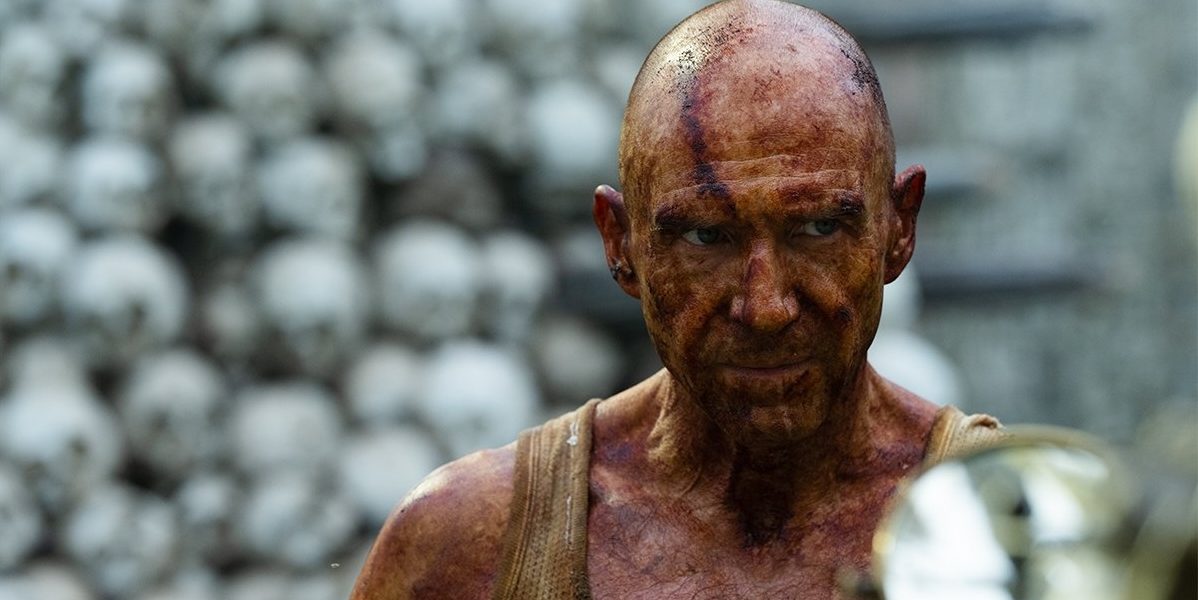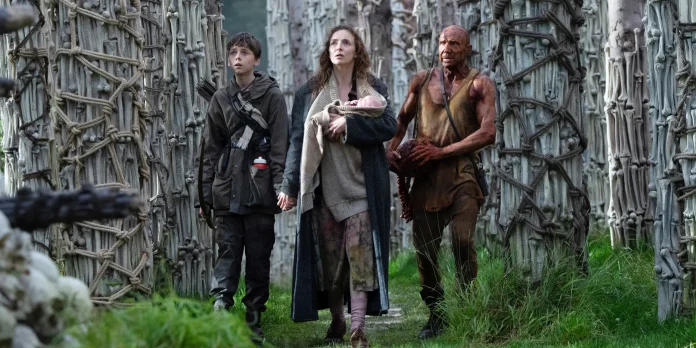Sixty-five feet beneath the streets of Paris, you’ll find their catacombs, where the bodies of six million are buried. Endless walls of skulls, femurs, radius and ulna reveal a labyrinthian network of tunnels, ornamented with charnel crosses and bone tombstones. These paths of the dead act as a kind of ghostly time travel, forcing you to imagine who they were, what choices they made, and how, soon enough, we’ll join them. Above one entombed doorway reads “Arrête! C’est ici l’empire de la Mort,” which translates to “Stop! Here lies the Empire of Death.“ Elsewhere, you see that frequently quoted expression from antiquity, “Memento Mori,“ or “remember you must die.“
Whether or not the flesh-eating fiends in Danny Boyle and Alex Garland’s “28 Days Later“ franchise are technically by-the-book zombies, the choice to make their decades-later legacy sequel a meditation on all things death is a risky but natural extension of the original’s DNA. By the end of the spine-yanking and disarmingly tender “28 Years Later,” they’ve delivered a rich, formally daring treatise on confronting death, how to accept it, and that passing from this world can become a richer, and more noble, experience when we’re able to decide it on our own terms.
To exhume those big ideas, we follow the young Spike’s (Alfie Williams) loss of innocence from the backwards isolationist community he grew up in –– the UK’s Holy Island, among the first invasion points of the vikings in England, and later a site of frequent religious pilgrimages, details that reinforce the historied nature of Spike’s village and arc –– and into the wilderness. That journey begins with Spike’s first “hunting“ expedition with his father, Jaime (Aaron Taylor-Johnson), entering the mainland to get his first arrow-shot kill of the infected.
Almost as a declaration of intent, Boyle begins their quest in a frenzied montage, intercutting their leaving of Holy Island with the Battle of Agincourt in Laurence Olivier’s “Henry the V,“ regraded grainy footage of the massacre in “28 Weeks Later,“ historical stock footage, and occasionally infrared images of the infected ravaging the woods, with “Boots“ by Rudyard Kipling chillingly narrated by Taylor Homes. History, fiction, myth, theater, and film are overlaid into one reality, a pure-cinema distillation of this entire project. It’s the perfect framing device for all Spike reckons with on his journey, starting with the ritualistic, bloody crowning of his coming of age through the father-son hunt. He gets his first kill, but upon an attack from an Alpha, an ultra-intelligent Infected that seems to control the rest, (another beat eerily similar to “Attack on Titan“ the popular anime Garland namechecked as an influence on his earlier “Men“) he panics, leaving him feeling emasculated and defeated. As drunk with pride and shame as pints of alcohol, Jaime announces his son a “giant killer“ at the village celebration, triggering Spike’s insecurities even further.
These early beginnings mark a crossroads for Spike, who at once wants to run away from home to protect and save his ailing mom, Ilsa (Jodie Comer), while also absorbing the dangerous value systems of masculinity and violence the town has used to survive. Jaime gets off on the thrill of death, to the point that when they encounter an entrailed cow carcass, he says of the putrid smell, “I weirdly like it.” It’s inevitable, then, that when he commands his father to leave after the discovery of an affair with the town rose leading to a quick knock across the face, Spike draws his knife. For both men, violence has become their primary mode of communication and conflict resolution, endemic in a town that, like the boys of old medieval England, bore mandates of archery. Even Jaimie’s more intimate paternal moments, like encouraging Spike that he did well in battle, reinforce these codes. The town, backwards-faced and adorned with the fixtures of Britain’s power structures in the past –– bloodied folk-horror masks, sentry guards, crossbows and barred gates, segregated disciplines, portraits of Queen Elizabeth II –– damns themselves as a war-society destined to see death (and life) through the lens of power and domination.
It’s only upon Spike’s meeting of the surprisingly welcoming Dr. Kelson (Ralph Fiennes) that he’s able to begin to shake free of that corrosive worldview. Kelson has constructed a grand sepulchral Bone Temple, which, like the catacombs beneath Paris, uses human remains as the building material to memorialize the dead. In the center stands a conical spire made only of skulls. It’s in that sacred space Spike learns the hard truths vital to his coming of age, forced to accept death as an implicit truth in the act of fully living; Spike learns his mother has cancer, and she wishes to die. What follows is a sequence of shocking beauty and frank enlightenment where Kelson euthanizes Ilsa, her choice characterized as a noble and heroic act. Not all deaths are equal, Kelson says, and passing from this world surrounded by love is as good as it gets. He reassures Spike of “memento amaris,“ Latin for “remember you must love”; here, death and love are intrinsically interlinked, a lesson Spike reluctantly absorbs as he takes his first steps towards independence.
 This worldview was absent in his own household, where Ilsa’s obsolescence was treated with containment verging on quarantine. Cleverly, the first jump scare of “28 Years Later“ comes not from one of the infected but from her, with Spike and Jaime’s breakfast interrupted by an explosion of commotion on the floor above, with an abrupt shift to woozy, frenetic camerawork– how Boyle shoots his monsters. Spike’s mom has become a metaphorical Living Dead, neither fully alive nor yet has shaken off her mortal coil, an idea initially hinted at in an infrared dream where Spike imagines his mother with glowing eyes speaking from a cursed sea. For a series famous for “not being about zombies,“ this is Garland’s thematic masterstroke, finding the genre’s humanist approximation from the tragedies of our own reality.
This worldview was absent in his own household, where Ilsa’s obsolescence was treated with containment verging on quarantine. Cleverly, the first jump scare of “28 Years Later“ comes not from one of the infected but from her, with Spike and Jaime’s breakfast interrupted by an explosion of commotion on the floor above, with an abrupt shift to woozy, frenetic camerawork– how Boyle shoots his monsters. Spike’s mom has become a metaphorical Living Dead, neither fully alive nor yet has shaken off her mortal coil, an idea initially hinted at in an infrared dream where Spike imagines his mother with glowing eyes speaking from a cursed sea. For a series famous for “not being about zombies,“ this is Garland’s thematic masterstroke, finding the genre’s humanist approximation from the tragedies of our own reality.
Whether together or apart, Garland and Boyle frequently push their characters to extremes, searching for dangerous answers in unknown horizons. What they often find instead are Kurtzian figures afflicted with an existential madness: rape rationalized for breeding and troop morale in “28 Days Later,“ a sun-worshipping murderous acolyte in “Sunshine,“ a missing soldier and husband in “Annihilation,“ a soldier filling a mass-grave with the prompt “What kind of American are you?“ in “Civil War.“ Likewise, nature has always played a recurring role, from the mountainous perils of “127 Hours“ to the cosmic horror of plant-human integration in “Annihilation.“ If it’s a cheap pull to sometimes say “this filmmaker’s entire career has led here”, in “28 Years Later,” it’s actually true, with one of Garland’s best screenplays bucking his own pattern. Kelson is introduced as a corpse-burning lunatic, but Spike is sternly cautioned to avoid him. However, it’s soon revealed that he’s the most caring and empathetic figure in the film, preaching a sermon of coexistence.
“28 Years Later“ ultimately becomes about the duty of care towards our loved ones and bloodthirsty monsters alike– as Kelson says, “because they are alike.“ It isn’t a trivial shift in genre convention; the monsters aren’t grave-resurrected zombies, like those in Romero’s or Peter Jackson’s “Dead Alive.“ They are diseased humans, the rage virus as the final result of apes “Clockwork Orange’d” with reels of war footage and civil violence. The world almost ended by turning human beings into rabid, people-eating animals. But uncomfortably, they are still us. This is a point each “28“ film hits in a new way, starting with Cillian Murphy becoming visually indistinct from an infected at the end of “28 Days Later,“ the U.S. army turning as dehumanized and destructive as the infected in “Weeks,“ and now Kelson’s “do no harm“sermon in “Years,“ inviting questions not only of death but the the right to life; if we can protect the infected, should we? Could we co-exist?
Living peacefully with ultraviolent people monsters is an absurd scenario, but if Kelson found a way to cohabitate amongst the violent beasts, what does it say about the rest of us who struggle to live with our neighbors? For Garland and Boyle, that might be a link to a Brexit UK, and the rest of Europe’s peaceful coexistence is a universal notion. Yes, a hazardous one, but that strangely sincere sentiment isn’t new to this series– the final theatrical cut of “28 Days Later“ has a famously optimistic ending that hints at salvation for our heroes, and Kelson’s worldview is a linear extension of that idea. Some have questioned why he repeatedly allows Sampson, the well-endowed Alpha who’s on the chase after Spike to seize his newly non-infected child (long story), to live. Kelson simply practices what he preaches, and the more time we spend with him, the more worryingly militant and regressed the Holy Island village becomes in retrospect. It’s our society that’s become poisoned with nostalgic eyes toward a mightier past, our filmmakers seem to say, and those who are purportedly the most socially dangerous are possibly the ones most worth hearing.
Maybe that’s why “28 Years Later“ uses the tools of digital cinema, specifically a well-kitted iPhone 15 Max, to gather a plurality of perspectives. Anywhere Boyle wants to put the small camera rigs– on the back of the bloated infected, the low-angled POV of a baby in a basket, across the shoulders of Kelson in the wilds, and running with a father as he rushes to find his runaway son — he does. Boyle’s showmanship with lo-fi digital experimentation allows for a richer intimacy with his characters, while the warped lenses, rough digital textures, and intense saturation give apocalyptic England the feel as if a lay-side smartphone captured our nightmares and dreams. It’s a look that’s both uncannily familiar and utterly alien all at once, bringing us uncomfortably close to a reality and worldview that might have felt dismissible under the flat gloss of typical movie visuals. According to Anthony Dod Mantle, it was Boyle who insisted on the iPhone, and I wonder if it was a way to put us into a state of radical acceptance for where this story takes us, as we use the fixtures of death to rediscover how to live.
It always should’ve been obvious that Garland and Boyle were never going to follow the usual legacy sequel moves. Instead, they made the 2025 equivalent of Brit punk rock counterculture, characterized by hard edges, fast drums, sudden tempo changes, rage at traditional notions of power, and all completed with invigorating sincerity. That’s made manifest in the film’s divisive coda, where a gang of blinged-out, tracksuited warriors appear and flip in the air like Power Rangers set to an electrifying, needle-drop of chunky metal as they wreck a legion of infected. They’re led by the clearly villainous Jimmy, modeled after alleged child predator Jimmy Seville, who (too eagerly) welcomes Spike into their midst. If Eisenstein enjoyed putting “firecrackers“ under audience seats as an awakening jolt, the final minutes of “28 Years Later“ are so combustive it’s the equivalent of Boyle planting C4 in each theater. Critiqued as unhinged sequel bait, it’s also the perfect ending for Spike’s character – his newfound understandings of mortality, life, and love will now be tested without the loving support of parents or Campbellian mentors, forcing him to actualize what he’s learned as he falls into a bad crowd. All he has to do is recall two simple truths, given by his now passed mother and Dr. Kelson: Remember, we must die. Remember, we must love.
Have you seen “28 Years Later?“ yet? What did you think of it? Please let us know in the comments section below and on Next Best Picture’s X account.


